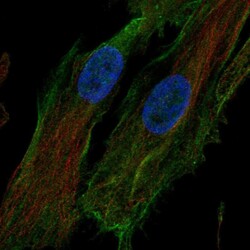Antibody data
- Antibody Data
- Antigen structure
- References [3]
- Comments [0]
- Validations
- Immunocytochemistry [1]
Submit
Validation data
Reference
Comment
Report error
- Product number
- HPA036655 - Provider product page

- Provider
- Atlas Antibodies
- Proper citation
- Atlas Antibodies Cat#HPA036655, RRID:AB_10671966
- Product name
- Anti-HTRA1
- Antibody type
- Polyclonal
- Description
- Polyclonal Antibody against Human HTRA1, Gene description: HtrA serine peptidase 1, Alternative Gene Names: ARMD7, HtrA, IGFBP5-protease, PRSS11, Validated applications: ICC, Uniprot ID: Q92743, Storage: Store at +4°C for short term storage. Long time storage is recommended at -20°C.
- Reactivity
- Human
- Host
- Rabbit
- Conjugate
- Unconjugated
- Isotype
- IgG
- Vial size
- 100 µl
- Concentration
- 0.1 mg/ml
- Storage
- Store at +4°C for short term storage. Long time storage is recommended at -20°C.
- Handling
- The antibody solution should be gently mixed before use.
Submitted references
Novel mutation in
HTRA1
in a family with diffuse white matter lesions and inflammatory features
The genomic landscape of schwannoma
Down-Regulation of HtrA1 Activates the Epithelial-Mesenchymal Transition and ATM DNA Damage Response Pathways
Ziaei A, Xu X, Dehghani L, Bonnard C, Zellner A, Jin Ng A, Tohari S, Venkatesh B, Haffner C, Reversade B, Shaygannejad V, Pouladi M
Neurology Genetics 2019;5(4)
Neurology Genetics 2019;5(4)
The genomic landscape of schwannoma
Agnihotri S, Jalali S, Wilson M, Danesh A, Li M, Klironomos G, Krieger J, Mansouri A, Khan O, Mamatjan Y, Landon-Brace N, Tung T, Dowar M, Li T, Bruce J, Burrell K, Tonge P, Alamsahebpour A, Krischek B, Agarwalla P, Bi W, Dunn I, Beroukhim R, Fehlings M, Bril V, Pagnotta S, Iavarone A, Pugh T, Aldape K, Zadeh G
Nature Genetics 2016;48(11):1339-1348
Nature Genetics 2016;48(11):1339-1348
Down-Regulation of HtrA1 Activates the Epithelial-Mesenchymal Transition and ATM DNA Damage Response Pathways
Batra S, Wang N, Eckert K, Zomorrodi A, Xin P, Pan W, Shearer D, Weisz J, Maranus C, Clawson G
PLoS ONE 2012;7(6):e39446
PLoS ONE 2012;7(6):e39446
No comments: Submit comment
Supportive validation
- Submitted by
- Atlas Antibodies (provider)
- Main image

- Experimental details
- Immunofluorescent staining of human cell line LHCN-M2 shows localization to plasma membrane.
- Sample type
- Human
 Explore
Explore Validate
Validate Learn
Learn Immunocytochemistry
Immunocytochemistry